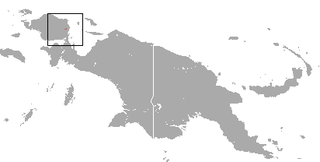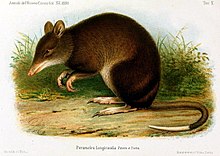
The order Peramelemorphia includes the bandicoots and bilbies; it equates approximately to the mainstream of marsupial omnivores. All members of the order are endemic to the twin land masses of Australia-New Guinea and most have the characteristic bandicoot shape: a plump, arch-backed body with a long, delicately tapering snout, very large upright ears, relatively long, thin legs, and a thin tail. Their size varies from about 140 grams up to 4 kilograms, but most species are about one kilogram, or the weight of a half-grown kitten.

Bandicoots are a group of more than 20 species of small to medium-sized, terrestrial, largely nocturnal marsupial omnivores in the order Peramelemorphia. They are endemic to the Australia–New Guinea region, including the Bismarck Archipelago to the east and Seram and Halmahera to the west.

The common echymipera, or common spiny bandicoot, is a bandicoot. It is long-snouted even by bandicoot standards. The upper parts are a coarse reddish-brown, flecked with spiny buff and black hairs. The tail is short and almost hairless. Length varies between 30 and 40 cm, with the tail accounting for an additional 8 to 10 cm ; the weight is from 0.6 to 2 kg.

The northern brown bandicoot, a marsupial species, is a bandicoot found only on the northern and eastern coasts of Australia and nearby islands, mainly Papua New Guinea. It is not, however, found far inland.

The three-striped dasyure is a member of the order Dasyuromorphia. This marsupial carnivore lives in West Papua and Papua New Guinea.

The marsupial family Peramelidae contains all of the extant bandicoots. They are found throughout Australia and New Guinea, with at least some species living in every available habitat, from rainforest to desert. Four fossil peramelids are described. One known extinct species of bandicoot, the pig-footed bandicoot, was so different from the other species, it was recently moved into its own family.

The southern brown bandicoot is a short-nosed bandicoot, a type of marsupial, found mostly in southern Australia. It is also known as the quenda in South Western Australia.

The long-nosed bandicoot, a marsupial, is a species of bandicoot found in eastern Australia, from north Queensland along the east coast to Victoria. Around 40 centimetres (16 in) long, it is sandy- or grey-brown with a long snouty nose. Omnivorous, it forages for invertebrates, fungi and plants at night.

The narrow-striped dasyure or narrow-striped marsupial shrew is a species of marsupial in the family Dasyuridae found in West Papua and Papua New Guinea. Its natural habitat is subtropical or tropical dry forests.

Clara's echymipera, or Clara's spiny bandicoot or white-lipped bandicoot, is a species of marsupial in the family Peramelidae. It is found in West Papua, Indonesia and Papua New Guinea. Its natural habitat is subtropical or tropical dry forests.

David's echymipera, or David's spiny bandicoot, is a species of marsupial in the family Peramelidae. It is found on the island of Kiriwina, in the Trobriand Islands of Papua New Guinea, and may be present on other nearby islands also.

Menzies' echymipera, or Menzies' spiny bandicoot or Fly River bandicoot, is a species of marsupial in the family Peramelidae. It is endemic to Papua New Guinea.

The long-nosed echymipera, or long-nosed spiny bandicoot, is a species of marsupial in the family Peramelidae. It is found in Australia, Indonesia, and Papua New Guinea. Its natural habitat is subtropical or tropical dry forests.

The mouse bandicoot is a species of marsupial in the family Peramelidae. It is endemic to West Papua, Indonesia. Its natural habitat is subtropical or tropical dry forests.

The Papuan bandicoot is a species of marsupial in the family Peramelidae. It is endemic to Papua New Guinea. Its natural habitat is subtropical or tropical dry forests. M. papuensis is a small bandicoot with a soft coat with a clear back, upper torso and face stripes. Its head to body length is 18–21 cm (7.1–8.3 in), the tail is 14–16 cm (5.5–6.3 in) long, the hind foot is from 43 to 47 mm long, the ears are 25 to 28 mm long and the animal weighs 145–184 g (5.1–6.5 oz).

The giant bandicoot is a species of marsupial in the family Peramelidae endemic to Papua New Guinea. Its natural habitat is subtropical or tropical dry forests.

Raffray's bandicoot is a species of marsupial in the family Peroryctidae. It is found in Indonesia and Papua New Guinea. Its natural habitat is subtropical or tropical dry forests.

The white-striped dorcopsis or greater forest wallaby is a species of marsupial in the family Macropodidae. It is found in the northern part of West Papua, Indonesia and Papua New Guinea. It is a common species in suitable tropical forest habitat and the IUCN lists its conservation status as being of "Least concern".

The Arfak pygmy bandicoot is a species of marsupial in the family Peramelidae. It is endemic to the Arfak mountains in the Vogelkop Peninsula of West Papua, in Indonesia. Its natural habitat is subtropical or tropical moist montane forests. The population is unknown and threats may be human expansion and hunting but it is protected by Arfak Reserve.
The eastern striped bandicoot is a species of marsupial in the family Peramelidae. It is found in eastern Papua New Guinea in the Enga Province. It is endemic to mountain forested habitats ranging from 1,000 – 3,600 m in elevation. The eastern striped bandicoot is a terrestrial omnivore.




















